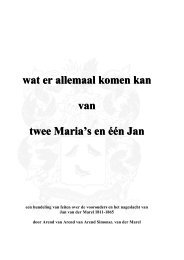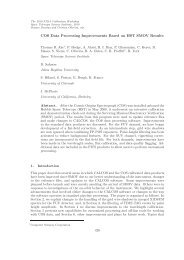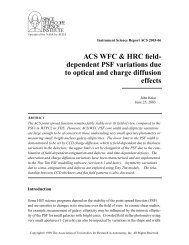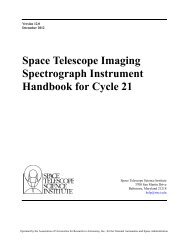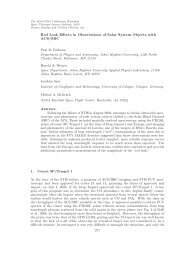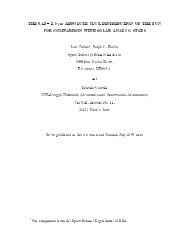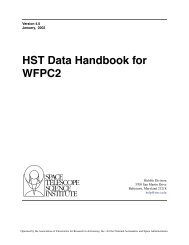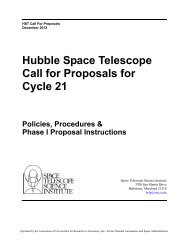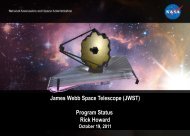STScI Annual Report 2002: A Living Mission
STScI Annual Report 2002: A Living Mission
STScI Annual Report 2002: A Living Mission
Create successful ePaper yourself
Turn your PDF publications into a flip-book with our unique Google optimized e-Paper software.
42 achievements<br />
Figure 3 displays the histogram by year of the number of<br />
refereed papers based on Hubble data that have not been<br />
cited. Understandably, there is a time delay between the<br />
publication of a scientific paper and the first paper citing it.<br />
After allowing a few years time, only about 2% of the<br />
Hubble based papers have no citations, whereas about one<br />
third of all refereed papers in astrophysics are never cited.<br />
This high level of productivity and impact reflects, in<br />
part, the care with which we select the science program.<br />
This year saw continued evolution in the process for<br />
selecting the Hubble science program. We made a major<br />
improvement with Cycle 12, reducing the time between<br />
submitting proposals and starting observations in an<br />
observing cycle. In prior cycles, the Phase I deadline<br />
occurred in mid-September, with observations starting the<br />
following July. For Cycle 12, we moved the Phase I deadline<br />
to the end of January 2003, with observations still starting<br />
in July. As a consequence the Telescope Allocation<br />
Committee did not convene in <strong>2002</strong> but will meet in March<br />
2003 for Cycle 12. Shortening the time between proposal<br />
deadline and cycle start will ensure that recent findings<br />
have greater influence on new Hubble observations,<br />
quickening the pace of scientific advance.<br />
We began the Hubble Treasury Program in the Cycle<br />
11 proposal solicitation. The HST Second Decade committee<br />
recommended this Program based on the observation that<br />
many of the highest impact results came from the largest<br />
programs. Recently compiled metrics (see Figure 4)<br />
support the conclusion that papers from larger programs<br />
1991 1992 1993 1994 1995 1996 1997 1998 1999 2000 2001 <strong>2002</strong><br />
publication year<br />
have higher impact: large programs produce about 30% more citations than small programs.<br />
Treasury programs are large programs to create major data sets with long-term significance and<br />
relevance to multiple scientific problems. The Treasury data sets are non-proprietary and immediately<br />
available to the community. In addition, we expect the observing teams to provide processed (science<br />
ready) data sets, catalogues, and other data products to the archive for the community’s use. Accepted<br />
Cycle 11 Treasury programs are now being carried out.<br />
For Cycle 12, we have taken several steps to further strengthen the Treasury Program. The Director<br />
established a Treasury Program Advisory Committee to provide continued advice on matters related to<br />
the selection and conduct of the Hubble Treasury Program.<br />
In November, the Institute organized a three-day workshop to foster high-quality Treasury proposals.<br />
The workshop examined scientific areas requiring large investments of Hubble time and aired science<br />
objectives, targets, and observing strategies, and brought potential collaborators together. More than<br />
70 scientists attended the workshop, which by all indications was successful in promoting community<br />
ideas and collaborations. In the future, we will hold Treasury Workshops in conjunction with the summer<br />
meeting of the American Astronomical Society.<br />
In Cycle 11, we created a new class of Archival Research (AR) proposals, called ‘Legacy’, to take<br />
advantage of the growing size of the Hubble data archive and develop the potential of large, homogenous<br />
data sets. Selected Legacy programs analyze specific data sets in a uniform manner, to deliver data<br />
products like catalogs, software tools, and web interfaces to the archive for the community to use.<br />
In Cycle 11 we also created the Hubble Theory Program, funded as part of the Hubble AR Program,<br />
to improve the interpretation and understanding of Hubble data. The Astronomy and Astrophysics Survey<br />
Committee of the National Research Council recommended funding such targeted theoretical research<br />
in conjunction with major observing facilities. Selected Cycle 11 programs in both these categories are<br />
being carried out.<br />
90%<br />
80%<br />
70%<br />
60%<br />
50%<br />
40%<br />
30%<br />
20%<br />
10%<br />
0%<br />
mean # of citations<br />
FIG 3: Refereed Hubble Papers Without Citations<br />
0%<br />
all Astrophysics HST papers<br />
1.8%<br />
1.8% 2.2% 2.5% 3.0%<br />
FIG 4: Citations Per Refereed Paper<br />
25<br />
20<br />
15<br />
10<br />
5<br />
0<br />
13.47<br />
1-10<br />
1.4%<br />
3.0%<br />
7.4%<br />
8.2%<br />
17.55 17.55<br />
16.16<br />
14.58 14.43<br />
14.6%<br />
11-20 21-50 51-100 1-50 51-100 >100<br />
program size (orbits)<br />
48.7%<br />
19.74



